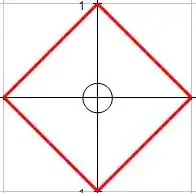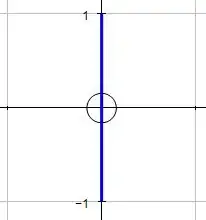The method which I adopt for constructing the triangle is very similar to the method used in the construction of the batman curve.
If you are not familiar with this technique I suggest you look at this answer concerning the construction of the batman curve so you may become familiar with the method.
Okay So I am trying to construct a right-angled triangle. First I start with this equation:
$$|x|+|y|=1$$ This produces a square as such:

Now to cut this in half I turn the absolute function into it's root representation and swap the square and radical for $x$: $$\left(\sqrt{x}\right)^2+\sqrt{y^2}-1=0$$
that produces this:

Now this is the first part of the equation.
Second part focuses on a line $x=0$ from $x=-1$ to $x=1$. This is what I came up with:
$$x\sqrt{1-y^2}=0$$

Now in theory I should be able to multiply the two expressions from the LHS of equation $1$ and $2$ to get my desired triangle. However this is not the case and the $2^{\text{nd}}$ expression becomes hidden. However what I have found is that if you add an arbitrarily small value to $x$ it becomes visible but it is not geometrically a triangle. So I have devised a hypothesis about the expression.
$$\left(\left(\sqrt{x}\right)^2+\sqrt{y^2}-1\right)x\sqrt{1-y^2}=0$$ The equation that doesn't work. $$\left(\left(\sqrt{x}\right)^2+\sqrt{y^2}-1\right)\left(\lim_{\epsilon\to0} x + \epsilon\right)\sqrt{1-y^2}=0$$ This is my hypothesis.
So my questions are:
Am I going down the right track in constructing a triangle if so:
- Is there anything I can do to improve my current work?
- Why is it that the second expression gets hidden?
If not:
- What route should I be taking?
- Is there a general equation for a triangle?